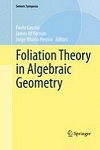MathSchoolinternational contain thousands of
Mathematics Free Books and
Physics Free Books. Which cover almost all topics for students of Mathematics, Physics and Engineering. We have also collected other
Best Free Math Websites for teachers and students.
for teachers and students.
Here is extisive list of
Algebraic Geometry Books . We hope students and teachers like these textbooks, notes and solution manuals.
Share this page:-

About this book :-
Foundations of Algebraic Geometry written by
Ravi Vakil
This book is intended to give a serious and reasonably complete introduction to algebraic geometry, not just for (future) experts in the field. The exposition serves a narrow set of goals, and necessarily takes a particular point of view on the subject.
Book Detail :-
Title: Foundations of Algebraic Geometry
Edition:
Author(s): Ravi Vakil
Publisher:
Series:
Year: 2022
Pages: 788
Type: PDF
Language: English
ISBN:
Country:
Get Similar Books from Amazon
Join our new updates, alerts:-
For new updates and alerts join our WhatsApp Group and Telegram Group (you can also ask any [pdf] book/notes/solutions manual).
 Join WhatsApp Group
Join WhatsApp Group
 Join Telegram Group
Join Telegram Group
Book Contents :-
Foundations of Algebraic Geometry written by
Ravi Vakil
cover the following topics.
Preface
For the reader, For the expert, Background and conventions, The goals of this book
PART-I PRELIMINARIES
Some category theory
Motivation, Categories and functors, Universal properties determine an object up to unique isomorphism, Limits and colimits, Adjoints, An introduction to abelian categories, Spectral sequences
Sheaves
Motivating example: The sheaf of differentiable functions, Definition of sheaf and presheaf, Morphisms of presheaves and sheaves, Properties determined at the level of stalks, and sheafification, Sheaves of abelian groups, and OX-modules, form abelian categories, The inverse image sheaf, Recovering sheaves from a “sheaf on a base”
PART-II SCHEMES
Toward affine schemes: the underlying set, and topological space
Toward schemes, The underlying set of affine schemes, Visualizing schemes I: generic points, The underlying topological space of an affine scheme, A base of the Zariski topology on Spec A: Distinguished open sets, Topological (and Noetherian) properties, The function I(·), taking subsets of Spec A to ideals of A
The structure sheaf, and the definition of schemes in general
The structure sheaf of an affine scheme, Visualizing schemes II: nilpotents, Definition of schemes, Three examples, Projective schemes, and the Proj construction
Some properties of schemes
Topological properties, Reducedness and integrality, Properties of schemes that can be checked “affine-locally”, Normality and factoriality, Where functions are supported: Associated points of schemes 164
PART-III MORPHISMS
Morphisms of schemes
Introduction, Morphisms of ringed spaces, From locally ringed spaces to morphisms of schemes, Maps of graded rings and maps of projective schemes, Rational maps from reduced schemes, ⋆ Representable functors and group schemes, ⋆⋆ The Grassmannian (initial construction)
Useful classes of morphisms of schemes
An example of a reasonable class of morphisms: Open embeddings, Algebraic interlude: Lying Over and Nakayama, A gazillion finiteness conditions on morphisms, Images of morphisms: Chevalley’s theorem and elimination theory
Closed embeddings and related notions
Closed embeddings and closed subschemes, More projective geometry, Smallest closed subschemes such that, Effective Cartier divisors, regular sequences and regular embeddings
Fibered products of schemes, and base change
They exist, Computing fibered products in practice, Interpretations: Pulling back families, and fibers of morphisms, Properties preserved by base change, ⋆ Properties not preserved by base change, and how to fix them, Products of projective schemes: The Segre embedding, Normalization,
Separated and proper morphisms, and (finally!) varieties
Separated morphisms (and quasiseparatedness done properly), Rational maps to separated schemes, Proper morphisms
Part-IV “GEOMETRIC” properties: Dimension and smoothness
Dimension
Dimension and codimension, Dimension, transcendence degree, and Noether normalization, Codimension one miracles: Krull’s and Hartogs’s Theorems, Dimensions of fibers of morphisms of varieties, ⋆⋆ Proof of Krull’s Principal Ideal and Height Theorems
Regularity and smoothness
The Zariski tangent space, Regularity, and smoothness over a field, Examples, Bertini’s Theorem, Discrete valuation rings: Dimension 1 Noetherian regular local rings, Smooth (and etale) morphisms (first definition), ⋆ Valuative criteria for separatedness and properness, ⋆ More sophisticated facts about regular local rings, ⋆ Filtered rings and modules, and the Artin-Rees Lemma
Part-V QUASICOHERENT SHEAVES
Quasicoherent and coherent sheaves
Vector bundles and locally free sheaves, Quasicoherent sheaves, Characterizing quasicoherence using the distinguished affine base, Quasicoherent sheaves form an abelian category, Module-like constructions, Finite type and coherent sheaves, Pleasant properties of finite type and coherent sheaves, ⋆⋆ Coherent modules over non-Noetherian rings
Line bundles: Invertible sheaves and divisors
Some line bundles on projective space, Line bundles and Weil divisors, ⋆ Effective Cartier divisors “=” invertible ideal sheaves
Quasicoherent sheaves on projective A-schemes
The quasicoherent sheaf corresponding to a graded module, Invertible sheaves (line bundles) on projective A-schemes, Globally generated and base-point-free line bundles, Quasicoherent sheaves and graded modules
Pushforwards and pullbacks of quasicoherent sheaves
Introduction, Pushforwards of quasicoherent sheaves, Pullbacks of quasicoherent sheaves, Line bundles and maps to projective schemes, The Curve-to-Projective Extension Theorem, Ample and very ample line bundles, ⋆ The Grassmannian as a moduli space
Relative versions of Spec and Proj, and projective morphisms
Relative Spec of a (quasicoherent) sheaf of algebras, Relative Proj of a sheaf of graded algebras, Projective morphisms, Applications to curves
Cech cohomology of quasicoherent sheaves
(Desired) properties of cohomology, Definitions and proofs of key properties, Cohomology of line bundles on projective space, Riemann-Roch, degrees of coherent sheaves, arithmetic genus, and Serre duality, A first glimpse of Serre duality, Hilbert functions, Hilbert polynomials, and genus, ⋆ Serre’s cohomological characterization of ampleness, Higher direct image sheaves, ⋆ Chow’s Lemma and Grothendieck’s Coherence Theorem
Application: Curvesy
A criterion for a morphism to be a closed embedding, A series of crucial tools, Curves of genus 0, Classical geometry arising from curves of positive genus 1, Hyperelliptic curves, Curves of genus 2, Curves of genus 3, Curves of genus 4 and 5, Curves of genus 1, Elliptic curves are group varieties, Counterexamples and pathologies using elliptic curves
⋆ Application: A glimpse of intersection theory
Intersecting n line bundles with an n-dimensional variety, Intersection theory on a surface, The Grothendieck group of coherent sheaves, and an algebraic version of homology, ⋆⋆ The Nakai-Moishezon and Kleiman criteria for ampleness
Differentials
Motivation and game plan, Definitions and first properties, Smoothness of varieties revisited, Examples, Studying smooth varieties using their cotangent bundles, Unramified morphisms, The Riemann-Hurwitz Formula
⋆ Blowing up
Motivating example: blowing up the origin in the plane, Blowing up, by universal property, The blow-up exists, and is projective, Examples and computations
Part-VI MORE
Derived functors
The Tor functors, Derived functors in general, Derived functors and spectral sequences, Derived functor cohomology of O-modules, Cech cohomology and derived functor cohomology agree
Flatness
Introduction, Easier facts, Flatness through Tor, Ideal-theoretic criteria for flatness, Topological aspects of flatness, Local criteria for flatness, Flatness implies constant Euler characteristic
Smooth, etale, and unramified morphisms revisited
Some motivation, Different characterizations of smooth and etale morphisms, Generic smoothness and the Kleiman-Bertini Theorem
Depth and Cohen-Macaulayness
Depth, Cohen-Macaulay rings and schemes, ⋆⋆ Serre’s R1 + S2 criterion for normality
Twenty-seven lines
Introduction, Preliminary facts, Every smooth cubic surface (over k) has 27 lines, Every smooth cubic surface (over k) is a blown up plane
Cohomology and base change theorems
Statements and applications, ⋆⋆ Proofs of cohomology and base change theorems, Applying cohomology and base change to moduli problems
Power series and the Theorem on Formal Functions
Introduction, Algebraic preliminaries, Defining types of singularities, The Theorem on Formal Functions, Zariski’s Connectedness Lemma and Stein Factorization, Zariski’s Main Theorem, Castelnuovo’s criterion for contracting (−1)-curves, ⋆⋆ Proof of the Theorem on Formal Functions 29.4.2
⋆ Proof of Serre duality
Introduction, Ext groups and Ext sheaves for O-modules, Serre duality for projective k-schemes, The adjunction formula for the dualizing sheaf, and ωX = KX
Bibliography
Index
?1



